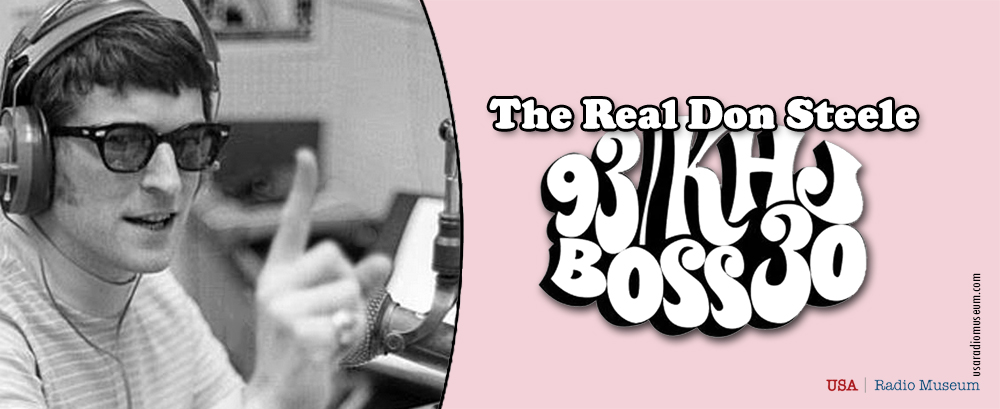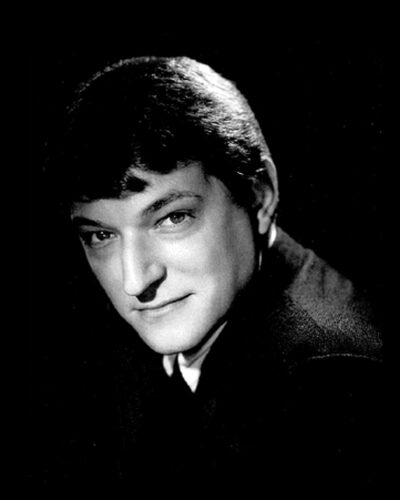“Alive—Alive!”: The Real Don Steele and the Golden Age of Boss Radio How one electrifying DJ turned a mic into a megaphone for a generation—and
“Alive—Alive!”: The Real Don Steele and the Golden Age of Boss Radio
How one electrifying DJ turned a mic into a megaphone for a generation—and changed radio forever.
Before he was “The Real” Don Steele—the electrifying voice that would blaze across the airwaves of Los Angeles—he was Donald Steele Revert, a kid born in Hollywood in 1936 with a name destined for neon lights. Raised by a single mother who played piano in silent movie theaters, Steele grew up surrounded by the flickering charm of old Hollywood, where dreams hovered in the smoggy skyline and every street corner seemed to whisper promises of fame.
Even as a child, Steele was drawn to the rhythm of performance. He didn’t dream of being a movie star—he wanted to command the air. That calling led him to the Don Martin School of Broadcasting, a springboard for aspiring DJs, where he cultivated the booming voice and sharp delivery that would become his trademarks. His first shot came on the dusty dials of KBUC in Corona, California—an unglamorous outpost, but one that let him experiment, take risks, and craft the energy-packed persona that would soon make the West Coast sit up and listen.
Steele’s early years weren’t just about finding airtime—they were about finding identity. With every shift behind the mic, he sharpened his timing, tested catchphrases, and turned static into spectacle. The foundations for “Boss Radio” were already stirring, and a revolution in rock and roll radio was about to explode—with Steele right at the epicenter.
The Hollywood That Raised Him
During Don Steele’s formative years in the 1930s and early 1940s, Hollywood was in the throes of its Golden Age—a time when the silver screen didn’t just reflect culture, it shaped it.
Musicals and escapism were king. With the Great Depression casting a long shadow, audiences flocked to theaters for dazzling spectacles starring Fred Astaire and Ginger Rogers, whose elegant dance routines and jazz-infused soundtracks helped define youth culture and social trends. Films weren’t just entertainment—they were a lifeline, offering hope, glamour, and a sense of possibility.
Technological innovation also played a huge role. The rise of “talkies” (films with synchronized sound) and the introduction of Technicolor transformed storytelling, making cinema more immersive and emotionally resonant. These advancements captivated young minds like Steele’s, who would later channel that same energy and immediacy into radio.
Genre films flourished, from screwball comedies and gangster flicks to westerns and horror. These stories often mirrored the anxieties and aspirations of the time, giving audiences both catharsis and connection.
And then there was radio—the other great cultural titan. While movies dazzled the eyes, radio dominated the ears. Families gathered around the set for news, drama, and music, and the booming voices of announcers became household companions. It’s no wonder Steele gravitated toward the microphone: he was growing up in a world where the voice could be just as powerful as the image.
Don Steele’s childhood in 1940s Hollywood wasn’t just colorful—it was a masterclass in showmanship. Surrounded by musicians, vaudevillians, and entertainers of every stripe, he absorbed the rhythms of performance like oxygen. His mother’s gigs took him from USO canteens to movie studio rehearsals, where he watched chorus lines, jazz bands, and even strippers rehearse their acts. That eclectic exposure gave him an instinctive feel for timing, flair, and audience connection—skills that would later define his radio persona.
He didn’t just learn how to entertain—he lived it. Watching his mother play piano for silent films taught him how to match energy to emotion, a trait that translated into his famously kinetic on-air delivery. The constant immersion in music—from swing bands to big band legends like Stan Kenton and Artie Shaw—shaped his musical sensibilities and helped him curate playlists that resonated with listeners on a visceral level.
Even his early job selling newspapers on the corner of Hollywood and La Brea taught him how to grab attention in a crowd. That same corner would later become the site of his Hollywood Walk of Fame star—a full-circle moment that symbolized how deeply his roots in Hollywood’s golden age influenced his rise as a radio icon.
In short, Steele didn’t just reflect the culture of his time—he channeled it, turning the razzle-dazzle of old Hollywood into a new kind of radio magic.
Road to the Revolution: The Rise Before the Boss
Don Steele’s path into radio was as bold and electric as the voice he’d become famous for. After graduating from Hollywood High School—where he played trumpet in the band—he briefly attended USC, but the classroom couldn’t contain his energy. With the Korean War looming, he enlisted in the U.S. Air Force, and after his service, he found his true calling at the Don Martin School of Broadcasting in Los Angeles. Not only did he study there, but he later returned to teach, already showing signs of the mentor and showman he’d become.
His early radio career was a whirlwind tour of the West Coast and beyond, each stop sharpening his style and building his legend. He started at KBUC in Corona, California, then moved north to KEPR in Kennewick, KIMA in Yakima, and KXLY in Spokane, all in Washington state. From there, he headed to KOIL in Omaha, Nebraska, where his program director gave him the moniker “The Real Don Steele”—a name meant to pop off the dial and stick in listeners’ minds.
He continued his westward climb through KISN in Portland, Oregon, and KEWB in San Francisco, where his high-octane delivery and magnetic presence began to draw serious attention. By the time he landed at KHJ in Los Angeles in April 1965, he wasn’t just ready—he was primed to ignite a radio revolution.
Boss Angeles Is Born
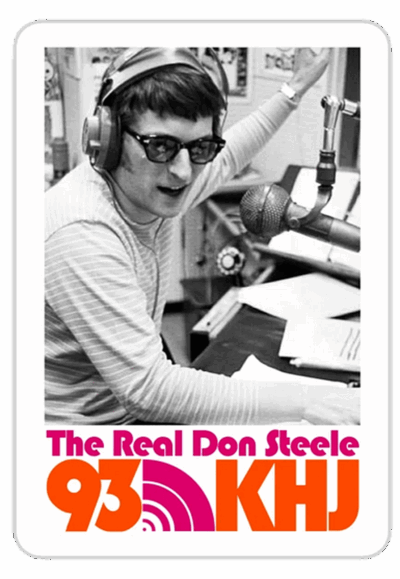 In 1965, radio consultants Bill Drake and Ron Jacobs had a bold vision for KHJ in Los Angeles: tighten the format, condense the playlist, and launch a slick new Top 40 era. They called it Boss Radio, and for its sonic vanguard, they needed not just talent—but thunder.
In 1965, radio consultants Bill Drake and Ron Jacobs had a bold vision for KHJ in Los Angeles: tighten the format, condense the playlist, and launch a slick new Top 40 era. They called it Boss Radio, and for its sonic vanguard, they needed not just talent—but thunder.
They found it in Robert W. Morgan and Don Steele.
KHJ re-launched on May 3, 1965, and within months, it had catapulted to number one. Gone were the rambling disc jockeys; in their place, punchy jingles, crisp segues, and high-octane voices that made music feel urgent. Steele owned the afternoon slot like a race car driver owns a track—fast, loud, flawless. His rhythmic delivery made every intro a rocket launch. His catchphrases like “Tina Delgado is alive—alive!” turned into cultural memes before memes existed.
When Don Steele joined KHJ in 1965, he wasn’t just stepping into a new gig—he was stepping into a revolution. Radio consultants Bill Drake and Ron Jacobs had a vision: to strip away the clutter, tighten the playlist, and inject Top 40 radio with a sleek, high-energy format that would become known as Boss Radio. And they needed the right voices to bring it to life. Enter Steele and fellow powerhouse Robert W. Morgan.
Drake and Jacobs had already tested their formula in smaller markets like Fresno and San Diego, but KHJ in Los Angeles was their proving ground. With Jacobs as program director and Drake masterminding the format, they launched Boss Radio on May 3, 1965. The station’s transformation was immediate and electric. Gone were the rambling DJs and bloated playlists—replaced by tight rotations, punchy jingles from the Johnny Mann Singers, and a relentless focus on momentum.
Steele’s arrival was like throwing gasoline on a bonfire. His rapid-fire delivery, booming voice, and infectious energy made him the perfect embodiment of the Boss Radio ethos. He didn’t just play records—he performed them, turning every shift into a sonic thrill ride. His afternoon drive-time slot became appointment listening, and his catchphrases (“Tina Delgado is alive—alive!”) became part of the cultural lexicon.
Within six months, KHJ rocketed to the top of the ratings, dethroning longtime rivals like KFWB and KRLA. The station rechristened Los Angeles as “Boss Angeles,” and Steele became its most recognizable voice. It wasn’t just a radio format—it was a movement, and Steele was its frontman.
KHJ | The Real Don Steele | June 14, 1968
Audio Digitally Remastered by USA Radio Museum
_____________________
A Sidebar: The Mystery of Tina Delgado
“Tina Delgado is alive—ALIVE!”
This cryptic phrase became one of The Real Don Steele’s most famous on-air signatures during his KHJ Boss Radio years—and to this day, it still stirs curiosity.
Where did it come from? One theory traces its origin to a real-life newspaper mishap in Portland, Oregon, where a woman named Tina Delgado was mistakenly listed as deceased. The retraction read: “Correction: Tina Delgado is alive.” Don Steele, ever the theatrical showman, is said to have spotted it and transformed it into a dramatic on-air chant—one that would echo across the L.A. airwaves.
But Steele himself never confirmed the tale. And he never explained its meaning.
Was it satire? A secret? A surreal slice of radio theater? No one knows for sure—and maybe that was the point. Like much of Don Steele’s mystique, the phrase was part performance, part legend, and entirely unforgettable.
“Tina Delgado is alive—ALIVE!”
A whisper, a roar, a riddle—and a lasting piece of radio folklore.
_____________________
The Face Behind the Mic: Television and Beyond
With charisma that couldn’t be bottled, Steele leapt to television with Boss City and The Real Don Steele Show, two KHJ-TV programs that aired from 1965 to 1975. These rock-and-roll dance shows showcased musical acts from the Supremes to the Stones, blending Steele’s DJ savvy with late-night variety flair.
He also made memorable cameos in cult films like Death Race 2000, Gremlins, Rock ‘n’ Roll High School, and Grand Theft Auto—often playing an exaggerated version of himself. His voice graced trailers and commercials alike, extending his brand into every corner of pop culture. Wherever there was a rhythm to be ridden, Steele was the jockey.
FM, Syndication, and Staying Power
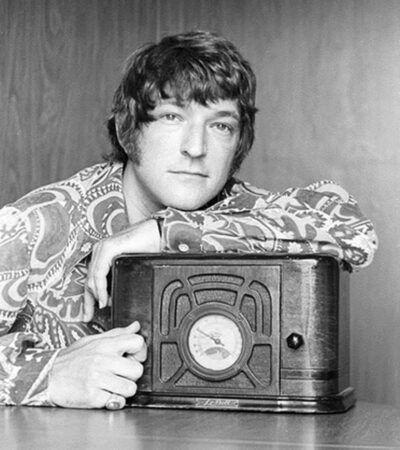 The 1970s and ’80s brought tectonic shifts in radio—AM faded, FM boomed, and personalities had to pivot. Steele didn’t just survive—he thrived.
The 1970s and ’80s brought tectonic shifts in radio—AM faded, FM boomed, and personalities had to pivot. Steele didn’t just survive—he thrived.
From KIQQ to KTNQ, KRLA, KCBS-FM, and eventually KRTH-FM (K-Earth 101), Steele became a linchpin of Los Angeles radio across decades. In 1988, alongside M.G. “Machine Gun” Kelly, he launched Live From the 60s—a nationally syndicated retrospective of music, sound bites, and memories that transported listeners back to the era he helped define.
Even after stepping away due to illness in May 1997, his shows kept airing. His voice, like his impact, refused to fade.
Don Steele’s charisma was too big to be contained by radio alone. As his fame soared at KHJ, he seamlessly crossed into television, becoming a familiar face as well as a voice. From 1965 to 1975, he hosted Boss City and The Real Don Steele TV Show on KHJ-TV Channel 9 in Los Angeles—a Saturday night rock-and-roll dance party that brought the energy of his radio show to the screen. With guest appearances from acts like The Rolling Stones and The Supremes, the show became a must-watch for teens across Southern California.
But Steele didn’t stop there. He popped up in cult classic films like Death Race 2000, Gremlins, Rock ‘n’ Roll High School, and Grand Theft Auto, often playing fast-talking, larger-than-life characters that mirrored his on-air persona. His voice also became a go-to for commercials and trailers, and he even narrated the U.S. theatrical trailer for Tomcats.
This cross-media presence wasn’t just a side hustle—it was a natural extension of his brand. Steele understood that entertainment was about connection, whether through a car radio, a TV screen, or a movie theater. He didn’t just ride the wave of pop culture—he helped shape it.
Even as the golden age of AM radio faded, Don Steele’s star never dimmed—it simply shifted frequencies. After leaving KHJ in 1973, he brought his unmistakable voice and kinetic energy to a string of major Los Angeles stations: KIQQ (K-100), KTNQ (Ten-Q), KRLA, KCBS-FM, and finally KRTH-FM (K-Earth 101), where he held court from 1982 until shortly before his passing in 1997.
In the mid-1980s, Steele’s career hit a lull, but a chance encounter with legendary voice actor Ernie Anderson reignited the flame. Within weeks, Steele was back on top, anchoring the drive-time slot at KRTH and launching the nationally syndicated show Live From the 60s. Co-created with fellow radio legend M.G. “Machine Gun” Kelly, the program was a time machine of sound, blending music, news clips, and Steele’s signature commentary to transport listeners back to the decade that made him famous.
His influence extended far beyond playlists and promos. Steele helped define what it meant to be a radio personality—not just a voice, but a presence. He inspired generations of DJs with his pacing, his punch, and his ability to make every listener feel like they were part of something electric. His catchphrase “Tina Delgado is alive—alive!” became a cult mystery, a wink to fans that still echoes in broadcasting lore.
In 1995, he received a star on the Hollywood Walk of Fame—fittingly placed at the very corner where he once sold newspapers as a boy. It was more than an honor; it was a homecoming.
Hollywood Cameo Moment
Once Upon a Time in Hollywood (2019)
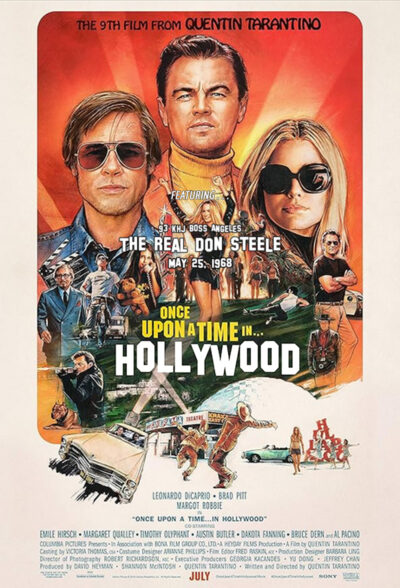 Director Quentin Tarantino made radio history part of movie magic by featuring authentic KHJ Boss Radio airchecks with The Real Don Steele in his 2019 film. Steele’s vibrant voice from May 25, 1968, can be heard blaring from car radios as characters cruise through a gorgeously recreated Los Angeles.
Director Quentin Tarantino made radio history part of movie magic by featuring authentic KHJ Boss Radio airchecks with The Real Don Steele in his 2019 film. Steele’s vibrant voice from May 25, 1968, can be heard blaring from car radios as characters cruise through a gorgeously recreated Los Angeles.
These aren’t just nostalgic nods—they’re actual broadcast recordings, complete with jingles and ads, lovingly restored to echo how Don Steele really sounded at the height of Boss Radio’s reign.
But Tarantino didn’t choose these airchecks by accident. He’s shared in interviews that his vision for the film was to sonically resurrect 1960s Los Angeles as he remembered it growing up. To do that, he needed more than music—he needed authentic radio. And no voice was more iconic, electrifying, or woven into the soundscape of L.A. than Don Steele’s. Tarantino used Steele not just to set the scene, but to evoke a very specific time and energy, letting the Boss Radio sound guide the audience through the city’s heartbeat.
“Tina Delgado is alive—ALIVE!”—still booming from the big screen, decades later.
Steele may not have appeared on screen, but his voice became a time-traveling narrator, reminding us that long before podcasts and playlists, radio ruled the rhythm of our lives.
KHJ The Real Don Steele Show | Once Upon A Time In Hollywood | May 25, 1968
Audio Digitally Remastered by USA Radio Museum
End of the Line: August 5, 1997
Don Steele’s most iconic moment—etched into the memory of radio history—was undoubtedly his role in launching Boss Radio at KHJ in 1965. That seismic shift in broadcasting, masterminded by Bill Drake and Ron Jacobs, turned Top 40 radio into a tightly produced, high-energy experience. Steele’s afternoon drive-time show became the heartbeat of that revolution. His rapid-fire delivery, signature catchphrases, and magnetic presence made him the soundtrack of Los Angeles for an entire generation. If there was ever a moment that defined him, it was those first months at KHJ, when he helped turn a struggling station into a cultural juggernaut.
Don Steele passed away on August 5, 1997, at his home in the Hollywood Hills, after a brief battle with lung cancer. He was 61 years old. Just months earlier, in May, he had retired from his final post at KRTH-FM due to health concerns.
His death sent a wave of grief through the broadcasting world. For many, it felt like the end of an era. KRTH aired a special tribute just days later, and tributes poured in from fellow DJs, fans, and industry legends. Colleagues like Charlie Tuna and Dick Clark reflected on his unmatched energy and influence. His signature phrase—“Tina Delgado is alive, alive!”—echoed across tribute broadcasts, a surreal reminder of the voice that had once made radios feel like rocket ships.
Listeners who had grown up with Steele felt the loss deeply. He wasn’t just a DJ—he was a companion, a cultural compass, and a master of the airwaves. His passing marked more than the loss of a man; it marked the fading of a golden age in radio, one where personality, pacing, and passion ruled the dial.
Legacy: Echoes That Never Fade
Awards & Recognition
- Hollywood Walk of Fame Star (1995)
On May 3, 1995, Don Steele received a star on the Hollywood Walk of Fame for his contributions to radio. Fittingly, it was placed at 7080 Hollywood Blvd., the very corner where he once sold newspapers as a boy—a poetic full-circle moment. - Inducted into the Radio Hall of Fame
Don Steele was posthumously inducted into the National Radio Hall of Fame, honoring his groundbreaking work in Top 40 radio and his enduring influence on the medium. His profile there highlights his role in launching Boss Radio, his nationally syndicated show Live From the 60s, and his decades-long dominance on the Los Angeles airwaves.
“I thought I respected the career of The Real Don Steele—until I started putting together his tribute. That’s when I realized: he didn’t just ride the wave of radio—he was the wave.”
—Keith Smith, KRTH-FM Production Director, from The Real Don Steele Remembered tribute broadcast.
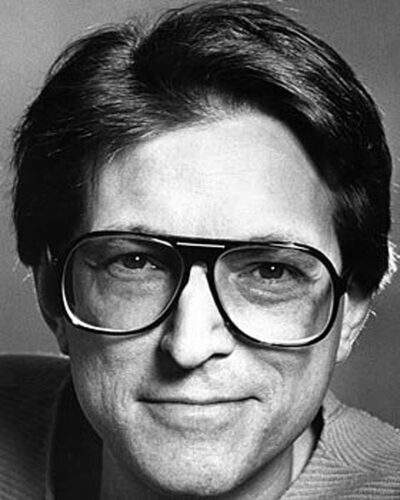 When Don Steele’s voice finally faded from the airwaves in August of 1997, the silence felt deafening. A legend had gone quiet. Though he had beaten the odds years earlier by quitting smoking in 1979, it was lung cancer that ultimately claimed him—suddenly, swiftly, and at the too-young age of 61. For a man who had lived his entire life with the volume turned all the way up, his passing felt unthinkably abrupt.
When Don Steele’s voice finally faded from the airwaves in August of 1997, the silence felt deafening. A legend had gone quiet. Though he had beaten the odds years earlier by quitting smoking in 1979, it was lung cancer that ultimately claimed him—suddenly, swiftly, and at the too-young age of 61. For a man who had lived his entire life with the volume turned all the way up, his passing felt unthinkably abrupt.
Yet what he left behind was thunderous.
From selling newspapers on the Hollywood streets as a boy to becoming the pulsing voice of a generation, “The Real” Don Steele wasn’t just a DJ. He was the DJ—one who didn’t speak at you but with you, turning commutes into concerts and songs into memories. His listeners didn’t merely tune in; they leaned in. His colleagues didn’t just admire him; they aspired to be him.
The day he died, thousands of radios across Los Angeles and beyond crackled with tributes, jingles, and that iconic phrase: “Tina Delgado is alive—alive!” It echoed not as a mystery anymore, but as a eulogy—part wink, part roar, and all Steele. His loss marked the end of an era, but his spirit remained, baked into the DNA of modern broadcasting, reverberating in every slick segue and every DJ who dares to believe the mic can still work magic.
Because Don Steele wasn’t just real. He was unforgettable.
_____________________
A USARM Viewing Tip: On your PC? Mouse/click over each image for expanded views. On your mobile or tablet device? Finger-tap all the above images inside the post and stretch image across your device’s screen for LARGEST digitized view.

